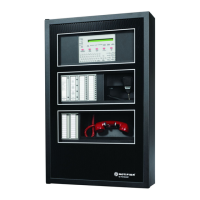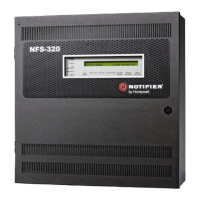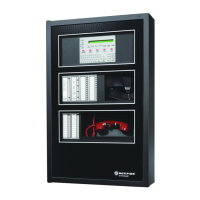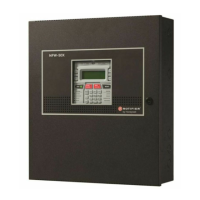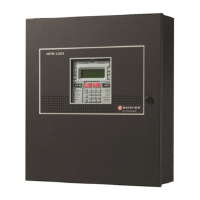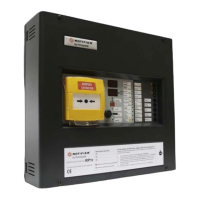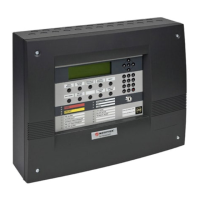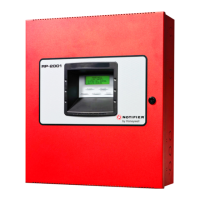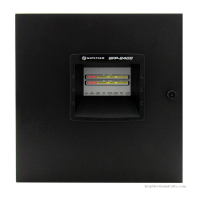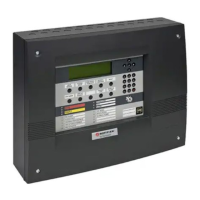NFS2-3030 Listing Document — P/N LS10006-051NF-E:F2 5/19/2022 57
Time-Based Functions:
When programming time-based logic equations, the following rules apply.
• Only one time-based function may be used in an equation.
• The time-based function must appear only once, as the first entry of the equation.
• It may not be nested within parentheses in the equation.
• Logic functions may be used in an equation that begins with a DEL or SDEL time-based function: however, they must appear within parentheses
following the time-based function.
Evaluating an Equation
To evaluate an equation, start from the innermost part of the equation and work outwards. For this equation to evaluate TRUE and thus turn on any
output mapped to it, the following conditions must be met:
OR(AND(L1D1,L1D4),AND(L2D6,L2M3,NOT(L2M4)),ANYX(2,L1M13,L1M14,L1M15))
Selecting a logic zone (ZL1 through ZL1000) in the Point Select of the Point Programming screen will display the following logic zone programming
options:
*For use with local SCS installations.
“DEL” Function Used for delayed operation.
Example
: DEL(HH.MM.SS, HH.MM.SS,AND(L1M1,L1M140))
The first HH.MM.SS is the delay time, the second HH.MM.SS is the duration time. If the argument - AND(L1M1,L1M140) - in the
example above activates, the function becomes true after the argument has been active for the delay time, and continues to be
true for the duration time as long as the argument stays active. If the argument goes inactive during the delay time or the duration
time, the function reverts to false and the timing would begin all over again if reactivated.
If duration time of zero is entered (00.00.00), the equation will evaluate true when the delay time expires if the argument remains
active throughout the delay time period.
If no duration or delay is specified, then the function will follow the input argument, indicating true while it is active and false when it
is inactive. DEL assumes a value of false on reset.
“SDEL” Function A latched version of the DEL function.
Example
: SDEL(HH.MM.SS, HH.MM.SS,L1M140)
The first HH.MM.SS is the delay time, the second HH.MM.SS is the duration time. If the argument (L1M140 in the example above)
activates, the function becomes true after the delay time, and will remain active for the duration even if the argument becomes
inactive during either the delay or duration time.
If delay time of zero is entered (00.00.00), the equation will evaluate true as soon as the argument (L1M140) activates and will
remain that way for the specified duration, even if the argument becomes inactive during that time.
If no duration or delay time is specified, then the argument will not deactivate until reset, even if the argument becomes inactive.
“TIM” Function The TIM function is used to specify activation on specific days of the week or year.
Examples
:
TIM(7-11-06) will evaluate as true for 24 hours starting at midnight (00:00:00) on July 11, 2006.
TIM(MO,TU,WE,TH,FR,08:00:00,23:00:00) will evaluate as true at 8:00 AM and remain true until 11:00 PM (23:00) for the list of
days supplied.
TIM(MO,TU,WE,TH,FR,08:00:00) will evaluate as true at 8:00 AM and remain true until 23:59:59 of the current day for the list of
days supplied.
TIM(TU,07:45:00,18:30:00) will evaluate as true every Tuesday between 7:45 AM until 6:30 PM.
TIM(MO,TU,WE,TH,FR) will evaluate as true from Monday morning at 12:01 AM until Friday evening at 11:59:00 PM.
These have
to be ON
These have
to be ON … and this OFF
Any TWO of these
have to be ON
for this part to be TRUE
for this part to be TRUE
for this part to be TRUE
When this is TRUE OR When this is TRUE OR When this is TRUE
Then all outputs programmed with this equation will be turned ON.
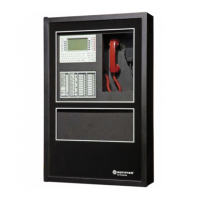
